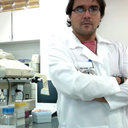Association of polymorphisms of endothelial nitric oxide synthase (eNOS) gene with the risk of primary open angle glaucoma in a Brazilian population.
Słowa kluczowe
Abstrakcyjny
The present study aimed to investigate the association of endothelial nitric oxide synthase (eNOS) gene polymorphisms with primary open angle glaucoma (POAG). We conducted a case-control study that included 90 patients with POAG and 127 healthy controls whose blood samples were genotyped for the functional polymorphisms T-786C and Glu298Asp of the eNOS gene by Taqman fluorescent allelic discrimination assay. The T-786C polymorphism was significantly associated as a risk factor for POAG among women (OR: 2.28; 95% CI: 1.11 to 4.70, p=0.024) and marginally associated to the risk of POAG in the patients ≥52 years of age at diagnosis (OR: 2.11; 95% CI: 0.98 to 4.55, p=0,055). However, these results was not confirmed after adjustments for gender, age, self-declared skin color, tobacco smoking and eNOS genotypes by multivariate logistic regression model (OR: 2.08; 95% CI: 0.87 to 5.01, p=0.101 and OR: 2.20; 95% CI: 0.95 to 5.12, p=0.067, respectively). The haplotype CG of T-786C and Glu298Asp showed a borderline association with risk of POAG in the overall analysis (OR: 1.76; 95% CI: 0.98 to 3.14, p=0.055) and among women (OR: 2.02; 95% CI: 0.98 to 4.16, p=0.052). Furthermore, the CG haplotype was significantly associated with the development of POAG for the age at diagnosis group ≥52 years (OR: 3.48; 95% CI: 1.54 to 7.84, p=0.002).We suggested that haplotypes of the polymorphisms T-786C and Glu298Asp of eNOS may interact with gender and age in modulating the risk of POAG.




